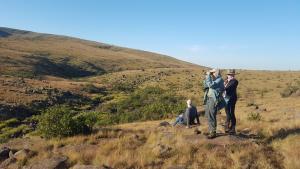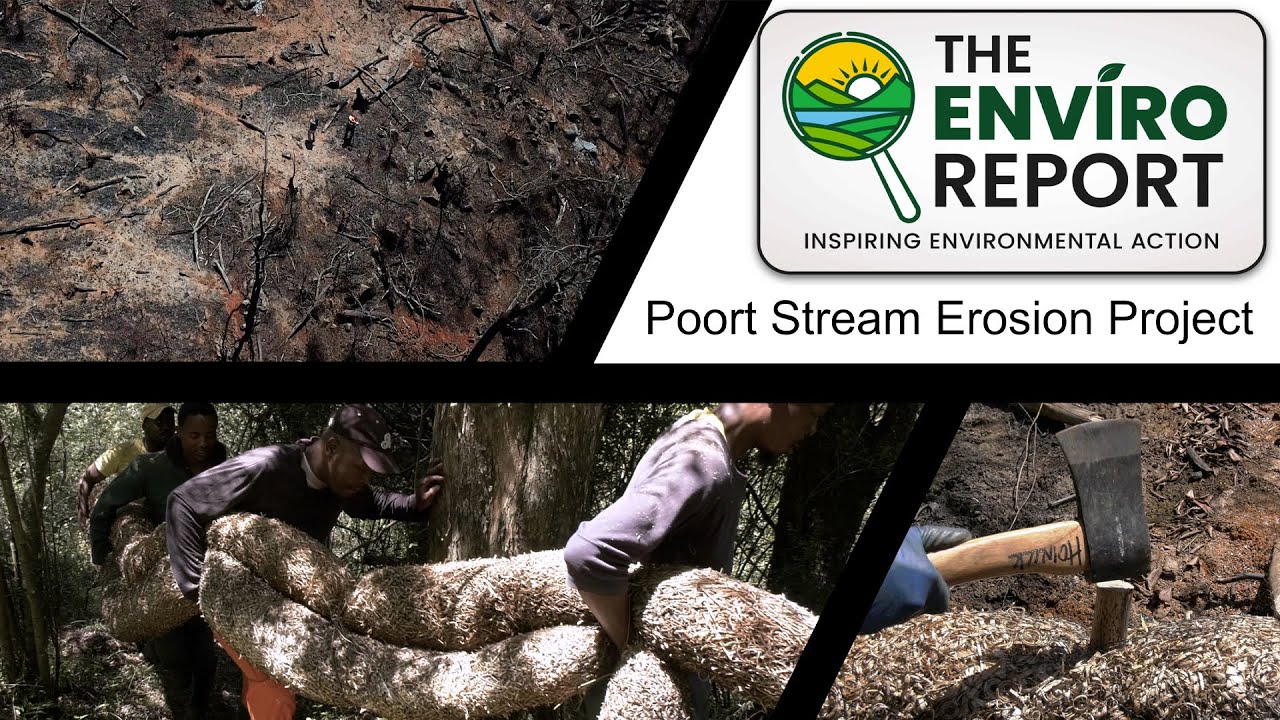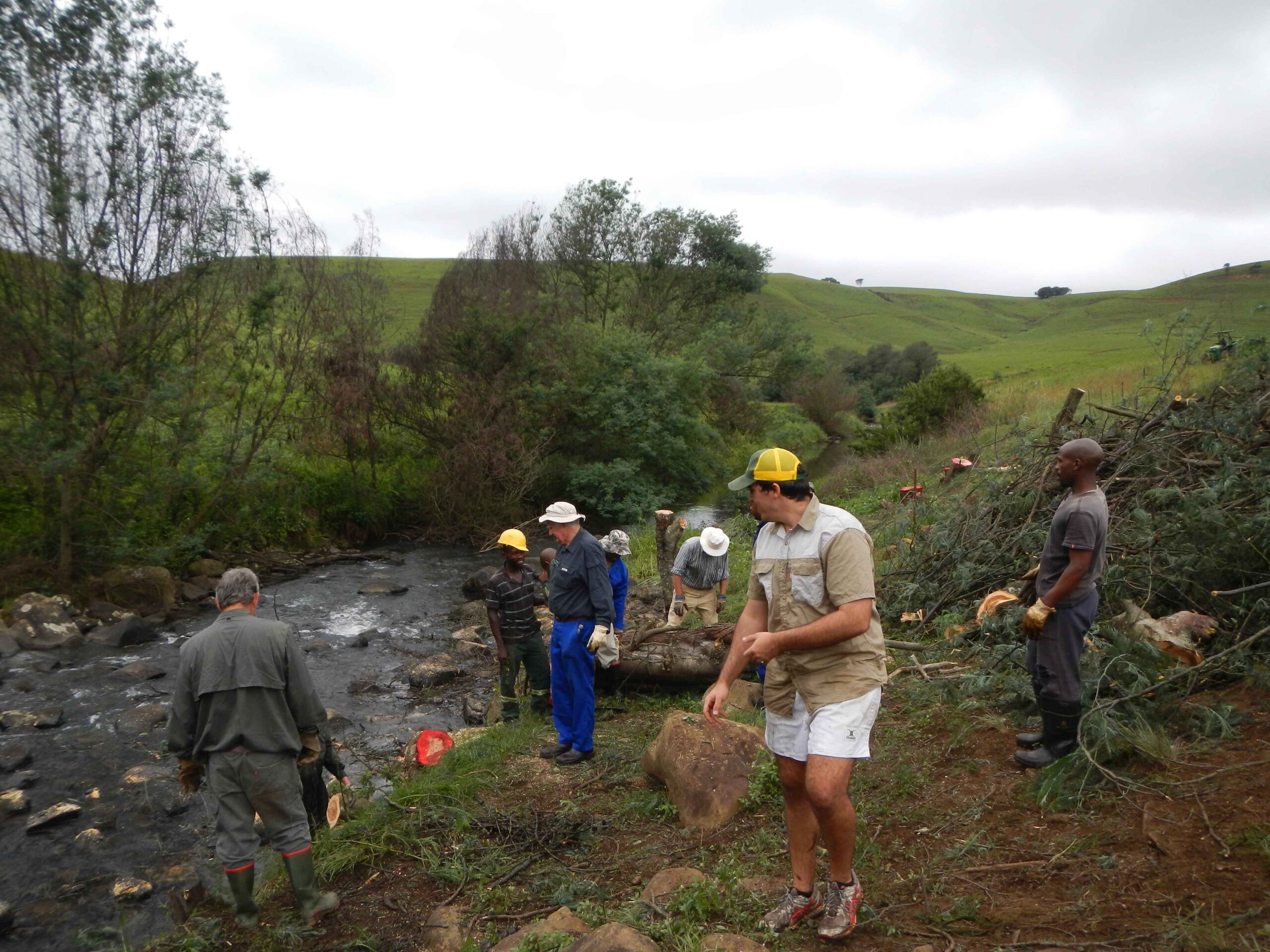Bazil Roth and his wife Petra are committed custodians of the land. On any given day, you might find Petra pulled off on the side of the road unhitching a fence that a poacher has lifted to gain access, and Bazil out on the reserve inspecting wattle clearing along the diminutive headwaters of the beautiful Elands River.
The fencing in question encloses the Tillietudlem Nature Reserve, and the Elands River flows through it, in cool high country that is studded with rock outcrops and pockets of indigenous forest. This reserve, which belongs to Chris Wilkinson, is managed by Bazil and Petra, who have a remarkable commitment to the reserve.
We are pulled off the side of the track watching a herd of Nguni cattle, and quizzing Bazil as to why there are cattle in a Nature Reserve. He explains, that in modern times, the countryside is so plotted and pierced with fences and roads and development, that the large grazing animals of times-gone-by, can no longer maintain migrations through the area, and so cattle are used for their large, indiscriminate grazing mouths. The cattle are the lawnmowers that come along and even out the veld, eating the least desirable species along with the sweetest, unlike the wildebeest that we saw earlier, which pick at just the best stuff.
It was winter when we visited, so it was difficult to pick out grass species, which had already shed their seed heads, but after a quick glance around, Steve McKean of Conservation Outcomes was able to find a sward of ThemediaTriandra (Redgrass) and show it to us. This is the most prized species, and its prevalence is an indicator of grassland health. Grassland health is very close to Steve’s heart, and as we walked through an area of veld, Steve and Bazil chatted about plans to burn this block come the end of winter. Steve explained that the grass becomes old and moribund, and young shoots are shaded by cascading grasstops, such that the level of basal cover is at risk of diminishing. Basal cover describes how much of the ground surface area is covered in actual grass plants, and how much is barren and at risk of sheet erosion. Steve explains that through active fire management, the grassland can be coaxed to maintain a dense basal cover and a good mix of species. This particular veld, on the lower part of the farm, is moist Midlands Mistbelt Grassland, a rare and fast diminishing classification of grassland that Tillietudlem is working hard to preserve. It is a particularly diverse biome, coming a close second to Fynbos in its number of plant species.

One of the threats to good quality grassland, is the invasion of alien plants. On Tillietudlem, that would be, American Bramble, Gum trees, and Wattle trees, with some Bugweed in the mix. Removing these species and keeping them out, is an enormous and expensive task. With the support of people like BirdLife South Africa, and Conservation Outcomes, Bazil works tirelessly to stay on top of the task. He tells us that they have measured fourteen kilometres of streams that were infested with Wattle, and that they have succeeded in clearing ten of those. Bazil explains that after the initial clearing of mature trees, cleared areas need active maintenance every year, and the problem never really goes away. As a result, each time they clear a kilometre of mature trees, they multiply the amount of work required annually in keeping all the streams clear.
That clearing is done by hand. A team of labourers fell trees, cross-cut them to manageable sizes, and carry the timber out to the farm road by hand! It is an enormous task. Bazil takes us to a steep ravine, where we walk upriver to a beautiful waterfall, and he shows us the steep footpath where they hauled logs out on their shoulders. The valley below the waterfall is flanked by remaining indigenous forest, where we find a clawed log, and postulate whether the claws may have been those of a leopard. It’s quite possible, says Bazil. Behind him, is tall riverine grassland, and dotted around are small wattle saplings that have sprung up. These saplings come from seed, which is prompted to germinate by fire and continues to do so for up to fifty or sixty years after it has fallen from the tree. The fire remains essential for the grassland, so the work in keeping the wattle out is destined to be ongoing long after all of us have departed.
It seems fitting, therefore, that Tillietudlem has recently been proclaimed a nature reserve. This legally binding status is noted on the title deeds of the property, and secures the land against potential cultivation, developments and commercial forestry in perpetuity. This important legal framework is one that Conservation Outcomes and BirdLife South Africa partnered with Tillietudlem to achieve. The proclamation is one they are rightly proud of, and it is a notable and definitive win for the environment. It also cements the fact that this farm will forever achieve an income for its owner only through environmentally friendly endeavours like eco-tourism. On that front, Tillietudlem has two lodges. One is an upmarket catered lodge, with high ceilings, and grand fireplaces. The other is a self-catering lodge with a deck out front, looking onto a waterfall on the Elands River, with a plunge pool below. Fly fishing is also offered in several dams on the property, and because there is no dangerous game, walking and cycling are possible in the reserve.
Bazil points out the unique situation of Tillietudlem, being on high ground, away from all other habitation, with excellent stargazing, and at the same time, just a half-hour drive from a great many of the attractions on the Midlands Meander.
Of course the COVID pandemic has hit the reserve hard, as it has all other accommodation venues. The financial woes that have accompanied the pandemic, also threaten to diminish grant funding on which the reserve relies for its clearing of alien trees. But Bazil remains positive and committed, and talks with determination of the coming summer season, when the focus changes from wattle clearing to bramble spraying. This endeavour, like many others at the reserve, generates employment opportunities for the nearby community of Impendle. Tillietudlem is in regular collaboration with the local community, resolving poaching issues; discussing the grazing land on the flank of the reserve that Tillietudlem makes available to local herdsmen; and planning contract work that supports the local economy.

Tillietudlem is a shining example of what private landowners can do towards this country’s conservation ambitions. As organs of state suffer burgeoning financial and management problems, it is private landowners like Chris Wilkinson and his managers who hold the conservation torch. They struggle on small budgets and have to learn to live with slow, steady and often frustrating levels of progress towards their ambitions, but they are moving forward and achieving gains. As survivors of a free market, and with quality management like that of Bazil Roth, endeavours like Tillietudlem should be attractive outlets for the Corporate Social Investment ambitions of Corporate South Africa. Tillietudlem certainly is an attractive holiday destination, and guests can place some comfort in the fact that their stay is an enabler of good work.



